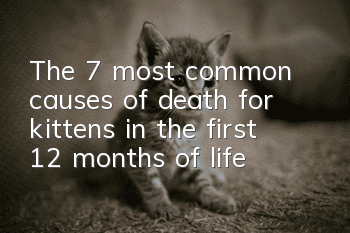The 7 most common causes of death for kittens in the first 12 months of life

Generally, a cat within 12 months of birth is in its juvenile stage, which is equivalent to a human from birth to 15 years old. During this period, cats need special care, otherwise they are likely to die young.
Killer 1: Congenital Abnormality
Congenital anomalies refer to abnormalities that appear in kittens at birth. Most of them are caused by genetic problems. Of course, X-rays or certain drugs can also cause abnormalities. Congenital abnormalities of the central nervous system, cardiovascular system, and respiratory system often cause kittens to die during birth or within 2 weeks, while other congenital abnormalities may not be noticed until the kittens can move fully autonomously.
Killer 2: Teratological effect
Some drugs and chemicals can cause teratogenesis and cause congenital abnormalities and early death in kittens. Therefore, during pregnancy, you should avoid giving any drugs and chemicals to female cats, especially steroids and those used to treat mold. Greymycin.
Killer Three: Nutritional Issues
If you feed a female cat inappropriate food, she is likely to give birth to weak or sick kittens. The most serious nutritional problem is the lack of oxen, which is currently known to cause fetal reabsorption, miscarriage, stillbirth, or birth. Stunted kittens. Causes of malnutrition in newborn kittens include severe maternal malnutrition, lack of adequate maternal blood supply to the fetus, or competition for placental space.
Killer Four: Underweight
If the kittens are underweight at birth, they will have a higher mortality rate. The cause of the kittens being underweight at birth is not yet clear, but premature birth, congenital abnormalities or nutritional deficiencies are all possible causes. Underweight at birth will not only cause six Kittens under one week old have a higher possibility of stillbirth and premature death, which can lead to chronic stunting of some kittens. Therefore, it is best to weigh the kittens when they are born and measure them regularly until they reach six weeks of age.
Killer Five: Neonatal Hemolysis
General domestic cats are less likely to suffer from neonatal hemolytic symptoms, but it is more likely to occur in some purebred newborn cats. This is because the colostrum of the mother cat is rich in transitional antibodies, and the intestines of newborn kittens can only absorb these transitional antibodies within 24 hours. Cats with blood type B have powerful anti-type A alloantibodies. When a female cat with blood type B gives birth to a kitten with blood type A or AB, the female cat’s colostrum will contain a large amount of anti-type A alloantibodies. Once a newborn kitten ingests colostrum within 24 hours, these anti-type A alloantibodies are absorbed into the body and combine with the kitten's red blood cells to dissolve them. This hemolysis will cause a variety of disease. newbornHemolytic symptoms in kittens often occur after ingesting colostrum. Most kittens will die suddenly without any clinical symptoms within the first day. However, some kittens will have reddish-brown urine, or may suffer from jaundice and The severe anemia continued to worsen and he died within one week of age.
Killer Six: Trauma
The so-called trauma mostly refers to dystocia, food addiction, or bad behavior of female cats. Photophagia mostly occurs in neurotic or highly sensitive female cats. It is quite common for female cats to eat their sick newborn kittens. However, we cannot blame all female cats' photophagia behavior on photophagia. This is to prevent healthy kittens from being infected, and to reduce unnecessary care and breast milk consumption. Mother cats usually do not pay attention to or take care of sick newborn kittens, and may even take them out of the nest or push them out of the cage. This behavior is difficult to distinguish from poor mothering.
Killer Seven: Production Count
According to statistics, the survival rate of kittens in the fifth birth is the highest. The survival rate of kittens in the first and fifth births is the lowest. The survival rate of kittens born to medium-sized female cats is higher than Large or small female cats have a higher birth rate, while numbers of five have the lowest premature death rate.
- A cat will die if it urinates for a few days
- Should you deworm yourself or go to a pet store?
- Are cat teasers harmful to cats?
- What should I do if my cat suffers from chronic gingivitis?
- Cat's nails are cracked with a thin layer
- Cats go crazy after eating mutton
- What does cat moss on a cat’s chin look like?
- Can cats reproduce after abdominal transmission is cured?
- What exactly is the sterilization shot for female cats?
- Can I still eat unopened cat food if it has expired?



